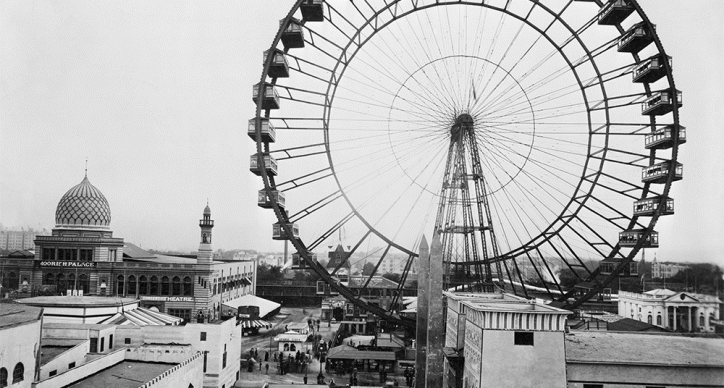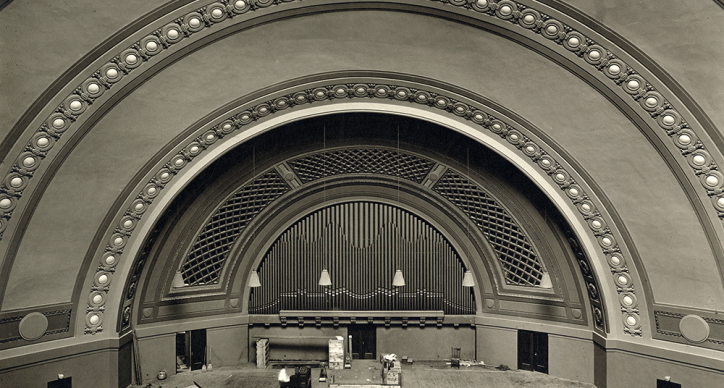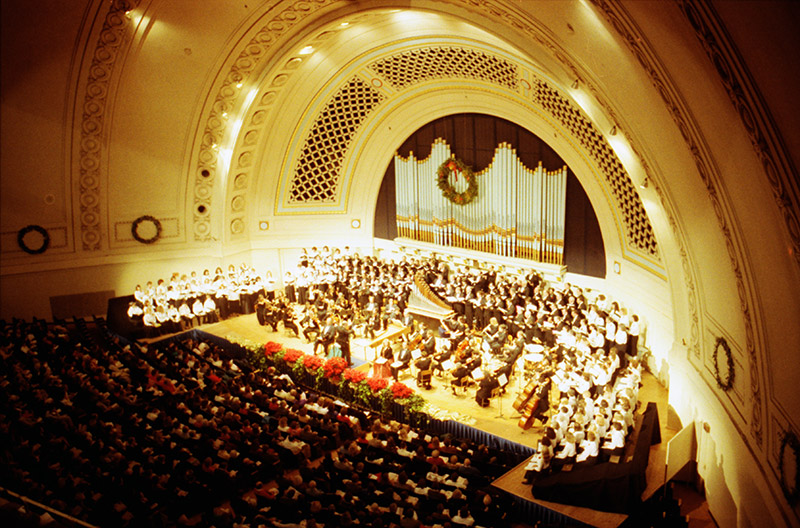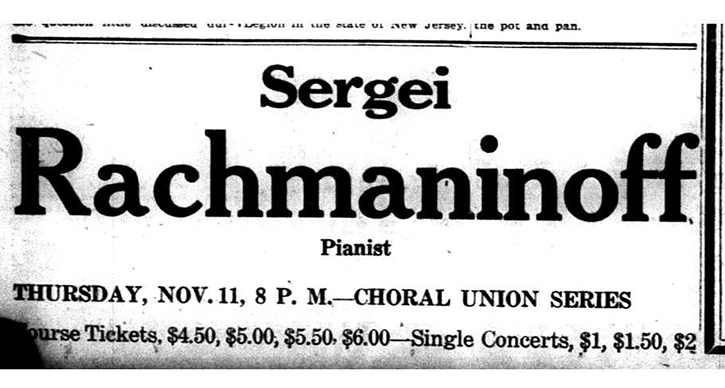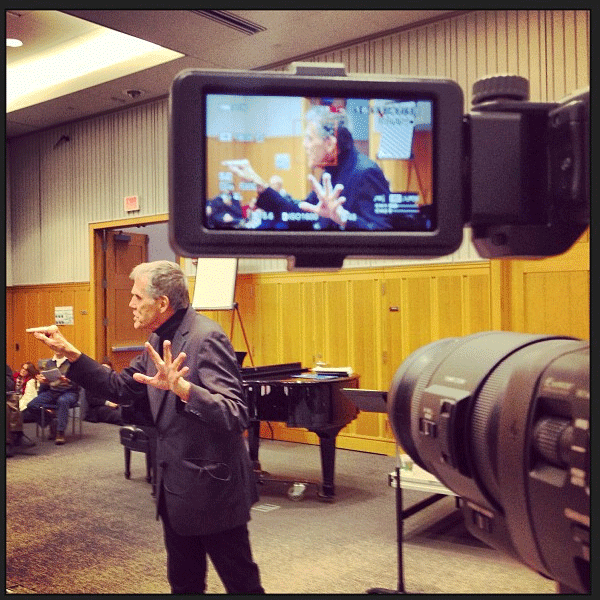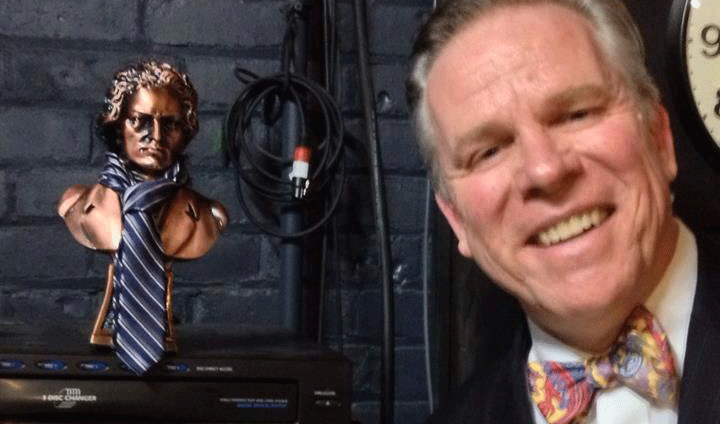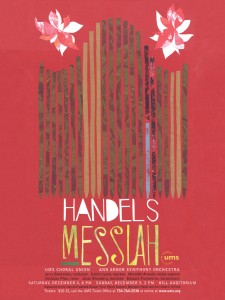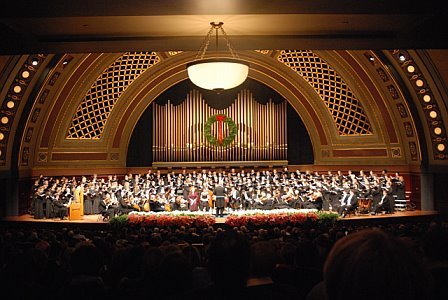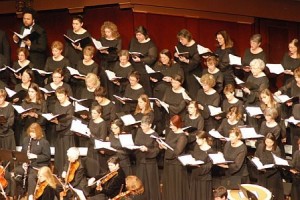Interview: UMS Choral Union Conductor Scott Hanoian

Photo: Scott Hanoian conducts the UMS Choral Union. Photo by Peter Smith.
Scott Hanoian had just completed his first season conducting the UMS Choral Union in the spring of 2016, when I met with him to chat about the job. As a member of the Programming and Artist Services staff at UMS, I have had the pleasure of hearing the Choral Union perform many times and was especially interested to hear about what Scott had to say about the new repertoire in store!
An organist, accompanist, and conductor, and graduate of the University of Michigan, Scott has held many jobs, including as the current director of music and organist at Christ Church Grosse Pointe, artistic director of the Oakland Choral Society, and faculty member at Wayne State University.
Saba Keramati: What caught your interest about conducting? When did this seem like the right career path for you?
Scott Hanoian: I really didn’t think about being a conductor at all until I was in college. I was an organ performance major at the University of Michigan, but I was also enrolled in beginning conducting class. A good friend of mine was an orchestral conductor, and he said, “You should come to orchestral rehearsals with Ken Kiesler.”
I remember they were doing Shostakovich 5, and I thought, “This is the coolest thing I have ever seen.” About the same time, I was in a conducting class with Jerry Blackstone [who conducted the Choral Union prior to Scott], and it was just clicking. Jerry and I got along really well, and he sent me an email that said something to the effect of, “You should give this a go. You clearly have some sort of knack for conducting.”
I started taking private conducting lessons with Jerry, and I actually enrolled in a graduate conducting seminar for non-conducting majors as an undergrad. Then they let me into the grad program here, and the rest is history. I completely fell in love with it.
SK: How was your first season as UMS Choral Union conductor?
SH: Good! For everybody, I think. One of the interesting parts of my work with the Choral Union is that there are different roles that I play. And this year, we’ve really done everything. I’ve prepared the chorus for someone else, I’ve done a piece they know, and I’ve done a piece that they didn’t know that I’ve conducted. So I’ve been able to experience everything that they do in one season. It’s been a bit of a whirlwind, but it’s a good start.
And I got to stand next to Alan Gilbert on the Michigan football field, so that was pretty cool. Even though I didn’t get to conduct. I wanted to conduct the Michigan marching band, but I’ll have to wait for that.
SK: How does it feel following in Jerry Blackstone’s footsteps after being his student?
SH: They’re big shoes. Big boots, as we say. He was probably my biggest mentor. He’s somebody that I look up to, and it’s an honor to be his successor. I never thought that would be possible. But I owe a lot of that to him because of what he taught me, the advice he’s given me about teaching, and the compassion he’s shown me. He’s the most gracious predecessor I could ever imagine and I love that about him. I am very lucky to have somebody like that just down the road.
UMS Choral Union prepares for Handel’s Messiah performances during 2015-16 season.
SK: What makes the UMS Choral Union special?
SH: They’re phenomenal singers. A group of intelligent, passionate, and really compassionate people that come together to make a commitment to the composer and piece that they perform. They are coming from all different walks of life: they’re working full time and singing, they’re students, they’re retired, they’re travelling all the time… but they come together Monday nights to sing phenomenal repertoire. I love working with people that are just so energetic about what they do.
SK: What should we look forward to in the 2016-17 season?
SH: Messiah, of course. We love Messiah [December 3 and 4, 2016]. They’ll also do some new repertoire. The Beethoven Missa Solemnis with the Ann Arbor Symphony at Hill Auditorium as well as with the Toledo Symphony [March 11 and April 28, 2017, respectively]. The singers will be working very hard, because not only will we be doing that, we’ll be preparing the Beethoven 9 for both the Budapest Festival Orchestra [February 10, 2017] and the DSO. We have a lot of a Beethoven on the horizon. That music will really showcase our singers.
SB: Anything else you want audiences to know?
SH: One of the things the Choral Union prides itself on is that we have no paid singers, it’s an all volunteer chorus, and it’s one of those groups that is entirely self-managed. We have vocal coaches and section leaders all within the group, and it’s a really great synergy of volunteers. It’s a chorus that runs itself. Obviously we work within the UMS auspices, and we have UMS staff liaisons, but there’s a certain corps of people that just sing because they love it. And I think that’s very important. They’re a very tight knit group, and they’re very loyal. I love that about them.
For more information on the Choral Union, including a list of their upcoming shows and audition opportunities, visit http://ums.org/about/choralunion/
The Great Pipe Organ
From April to October 1893, the World’s Columbian Exposition—called the “White City” for its alabaster architecture and its nightly illumination by millions of electric lights—drew the rapt attention of much of the world. Some 27 million people traveled to Chicago’s Jackson Park to see it. Of these, several hundred thousand entered the 10,000-seat Festival Hall to hear what was widely regarded as one of the greatest musical instruments—and certainly one of the largest—ever constructed.
It was a 3,901-pipe organ, 34 feet wide by 25 feet deep, 38 feet tall at its highest point, manufactured by the Farrand & Votey Company of Detroit to specifications drawn by the eminent organist Clarence Eddy of Chicago, incorporating features invented by Frank Roosevelt of New York City, first cousin to Theodore Roosevelt. It was one of the first great organs to rely on electrical connections from its keys to its pipes, which ranged from the size of soda straws to the size of tree trunks. Together they could replicate the sounds of a vast symphony orchestra.
Photo: The Ferris Wheel at the World’s Columbian Exposition
Over the six months of the fair, “the most eminent of contemporary organists” entertained crowds at 62 recitals in all. On the fair’s last day, Clarence Eddy himself wrote of the organ that “musically, it is worthy of rank among the few great organs of the world, while from a technical standpoint it occupies a supreme position.
Later the following winter, long after the last fair-goers had gone home, workmen entered Festival Hall, took the organ apart, packed the pieces in crates, and loaded the crates on rail cars bound for Cincinnati. After a few months in storage, the parts were packed up again and shipped to Ann Arbor.
In the era before radio and high-quality phonographs, when symphony orchestras were relatively rare, Americans of the late 19th and early 20th centuries listened to great pipe organs with a mixture of technological awe, local pride, and aesthetic rapture. Cities competed to buy the biggest and best. The steel baron Andrew Carnegie, famous as the benefactor of city libraries, also gave millions for municipal organs. Community fund drives were organized to buy instruments made by the most prestigious manufacturers and played by the most famous musicians. When the preeminent organmaker Ernest Skinner installed a new instrument in Cleveland in 1922—”The Finest Musical Instrument ever built by man,” ads said—a crowd of some 20,000 swept past police to squeeze into an arena built to hold only 13,000. (The show went on as planned.) The richest Americans had genuine pipe organs installed in their homes, and a new industry grew up to provide humbler home organs for the middle class.
For many years before the Columbian Exposition of 1893, Henry Simmons Frieze, professor of Latin and three times the University’s interim president, had argued for the installation of a first-class organ on the campus.
Frieze was the progenitor of Michigan’s musical tradition. A fine amateur organist, pianist and conductor, he launched student bands and choral clubs and introduced organ music to the daily chapel services. He persuaded the Regents to appoint the first professor of music. He was the principal founder of the University Musical Society (UMS), which was to make Ann Arbor a national center of fine music.
Frieze believed the shared experience of music was essential to a liberal education and to community life, and students agreed. In 1874, student journalists proposed a scheme by which a fine organ could pay for itself in six months through the sale of ten-cent tickets to all those who couldn’t afford a piano in their homes.
“Music,” they wrote, “good refining music, at a low price, is what the thousand homeless students and the poor people of this city are craving, and they will gratefully acknowledge as a benefactor whoever will furnish it to them.”
No benefactor stepped forward, and Frieze died in 1889, but his campaign for an organ soon was taken up by the University Musical Society. It was led by Professor A.A. Stanley, first dean of the new School of Music (and co-composer of the beloved U-M anthem Laudes Atque Carmina), and Francis W. Kelsey, professor of Latin (and namesake of the Kelsey Museum of Archaeology). Both were indefatigable organizers. First they raised money from townspeople to construct a new building for UMS. Then the two professors set their sights on Chicago, where, in the wake of the Columbian Exposition, the great Farrand & Votey organ was for sale.
The country was in the midst of a financial depression. Farrand & Votey had rented the organ to the Exposition for $10,000. Now they were asking a purchase price of $15,000—nearly $400,000 in 2010 currency. The University was in no position to pay such a sum for a musical instrument, however grand.
So Professors Kelsey and Stanley designed a public appeal. Major donations came from U-M alumni and music enthusiasts in Ann Arbor, Detroit, Grand Rapids, Chicago, and New York. More was raised through the sale of tickets to a grand inaugural concert—$5 to cover the cost of the concert plus train fare from anywhere in the state.
It was enough. For five months, workmen reassembled the organ in the auditorium of University Hall, then the central building of the campus, fronting State Street just east of where Angell Hall stands now.
On December 14, 1894, before a full house, Professor Kelsey declared that the organ was to be named in honor of Henry Simmons Frieze. Then he formally turned it over to the Board of Regents.
“Its splendid harmonies will ever please,” Kelsey said, “but those keys, touched by master hands, will speak a deeper message than that merely of beauty, of aesthetic pleasure. This organ will become an educational force in the hearts and lives of our young people…. May it touch and thrill their inmost natures…lifting them away from that which is mean and trivial into the clear shining of the ideal.”
* * *
Photo: Hill Auditorium stage in 1913.
The organ was played in University Hall for nearly 20 years, including at twice-a-week vesper services. In 1913, it was once again disassembled, moved a couple hundred yards to the north, then re-installed—with $16,000 worth of additions—as the centerpiece of the new Hill Auditorium. (It took an estimated 100 wagon trips to roll the components over to the new site.) It was played at countless performances, including regular “Twilight Recitals” for students enjoying late-afternoon respites after class.
In 1928 most of the organ’s parts were replaced in a major overhaul by Ernest Skinner—the designer whose installation in Cleveland had caused a near-riot six years earlier—but the new instrument remained the Frieze Memorial Organ. Further reconstructions and additions followed in 1955, 1985, 1990 (after extensive damage from a roof leak) and 1995, when digital circuitry and solid-state components were added.
According to James Kibbie, U-M professor of organ, the Frieze instrument now contains “120 ranks [of pipes] plus an additional 4 ranks in the Echo division above the central skylight, totaling 7,599 speaking pipes.” Of those 120 ranks, a dozen ranks remain from those that were manufactured at Farrand & Votey’s factory in Detroit—the last original components of the Frieze Memorial Organ.
Celebrate this Valentine’s Day on Sunday, February 14, 2016 at 4 pm with the UMS Choral Union Concert: Love is Strong as Death.
(Sources include James O. Wilkes, Pipe Organs of Ann Arbor (1995); James Kibbie, The Hill Auditorium Organ; James B. Angell, “A Memorial on the Life and Services of Henry Simmons Frieze” (1890); Frank D. Abbott, ed., “Musical Instruments at the World’s Columbian Exposition” (1895); Craig R. Whitney, “All the Stops: The Glorious Pipe Organ and Its American Masters” (2003), Charles H. Gray, “Musical Interests at the University of Michigan,” American University Magazine (1897); and “The U of M Organ,” The Song Journal (1895).)
This article appears courtesy of the online alumni magazine Michigan Today. It was published on May 12, 2010.
Outgoing UMS Choral Union Music Director and Conductor Jerry Blackstone Inspires $100,000 Gift
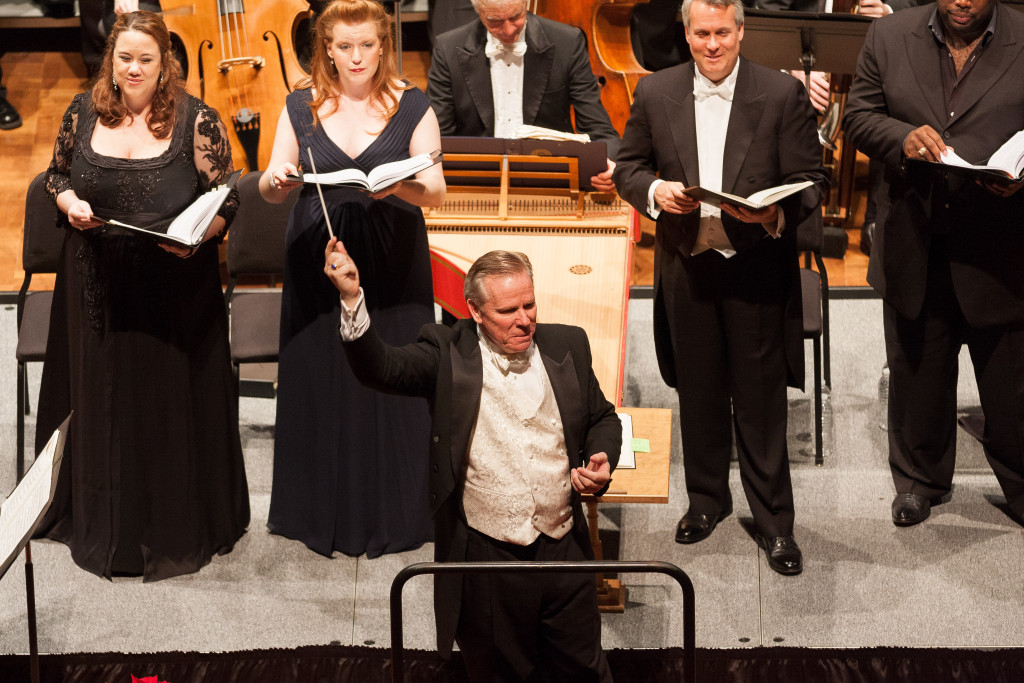 On Monday July 6, Jerry Blackstone, Director of Choirs and Chair of the Conducting Department at the University of Michigan, claimed the podium one last time as the UMS Choral Union Music Director and Conductor to lead singers in a reading of Francis Poulenc’s Gloria as part of the choir’s community music-making sessions entitled Summer Sings. A beloved Ann Arbor tradition, Summer Sings events bring together singers from all over the region to learn and sing together for one evening under the baton of some of our nation’s finest choral conductors. At the close of Poulenc’s monumental piece, participants basked in a moment of awe-inspired silence before erupting into appreciative applause for the timeless music, the memorable experience of singing together, and most importantly, for the work of Jerry Blackstone.
On Monday July 6, Jerry Blackstone, Director of Choirs and Chair of the Conducting Department at the University of Michigan, claimed the podium one last time as the UMS Choral Union Music Director and Conductor to lead singers in a reading of Francis Poulenc’s Gloria as part of the choir’s community music-making sessions entitled Summer Sings. A beloved Ann Arbor tradition, Summer Sings events bring together singers from all over the region to learn and sing together for one evening under the baton of some of our nation’s finest choral conductors. At the close of Poulenc’s monumental piece, participants basked in a moment of awe-inspired silence before erupting into appreciative applause for the timeless music, the memorable experience of singing together, and most importantly, for the work of Jerry Blackstone.
After 12 years of dedicated service as the UMS Choral Union Music Director and Conductor, Blackstone passed the baton to Scott Hanoian, whose appointment as the new leader of the UMS Choral Union began on July 1. In recognition of Blackstone’s service and incredible impact on the choir, the Jerry Blackstone UMS Choral Union Performance Fund was announced at Monday evening’s Summer Sings. Two anonymous donors, who wished to provide the UMS Choral Union membership with opportunities to perform an expanded repertoire of significant choral works, made gifts totaling $100,000 to establish the fund, which will be used to help pay for expenses related to the self-produced concert activities of the UMS Choral Union.
“The 175 volunteer musicians in the UMS Choral Union dedicate considerable time and talent for the benefit of our community. We are delighted to have a fund that will help enhance their experience through a robust season of choral repertoire,” said President Kenneth C. Fischer. “Jerry Blackstone has shown us that great music-making requires more than incredible technique and talent. It requires hard-work, thoughtful reflection, and a supportive community where musicians can be nurtured to see their fullest potential. The Jerry Blackstone UMS Choral Union Performance Fund recognizes the work of a beloved music director and paves the way for exciting projects to come.”
The fund is extended to all UMS Choral Union projects beyond UMS’s annual presentation of Handel’s Messiah that are not performed in partnership with a touring orchestra as part of UMS’s Choral Union Series or scheduled through the Detroit Symphony Orchestra as part of their concert series at Orchestra Hall.
Recent self-produced UMS Choral Union concerts include the 2015 presentation of Mendelssohn’s Elijah, the 2014 presentation of Brahms’s German Requiem, and the 2004 presentation of William Bolcom’s Songs of Innocence and of Experience, the Naxos recording that won three 2006 Grammy Awards (“Best Choral Performance,” “Best Contemporary Classical Composition,” and “Best Classical Album”).
In a recent interview, Karen Isble, Assistant Vice President for Development at the University of Michigan and longtime UMS Choral Union member, said of Blackstone: “Jerry has fostered the Choral Union community. His ability to be so musical and so warm and so inviting to everyone at every musical level really made the difference during his term as the music director.”
While the donors responsible for the Jerry Blackstone UMS Choral Union Performance Fund prefer to remain anonymous, they released the following statement about their gift: “Our hope is that this gift, and the naming of the fund in Jerry Blackstone’s honor, will encourage others who cherish choral music to add to the fund.”
While the end of an era is always bittersweet, the choir turns its eye to a promising future with incoming UMS Choral Union Music Director and Conductor Scott Hanoian, making his first public appearance in the new role at the next Summer Sings event on August 3 to lead a reading of Carl Orff’s Carmina Burana.
“Jerry Blackstone was a hugely influential teacher to me during my time as a music student at the University of Michigan and I’m honored to continue the tradition of great choral music-making in Ann Arbor, “ says Scott Hanoian. “The Jerry Blackstone UMS Choral Union Performance Fund will allow the choir to embark on the next chapter of our storied history. I can’t wait to see what will happen next.”
Donors interested in contributing to the Jerry Blackstone UMS Choral Union Performance Fund can do so online or connect with UMS Associate Director of Development Susie Bozell Craig at sbozell@umich.edu.
A Community of Singers, Right Here in Ann Arbor

Photo: UMS Choral Union on stage for Handel’s Messiah at Hill Auditorium. Photo by Mark Gjukich Photography.
Karen Isble is Assistant Vice President of Development at the University of Michigan, and she’s also been a member of the UMS Choral Union, Ann Arbor’s 137 year-old, Grammy Award-winning community choir, for nearly eight years.
We chatted with her about her most memorable experiences, including a performance in blizzard conditions, the community, and outgoing music director Jerry Blackstone.
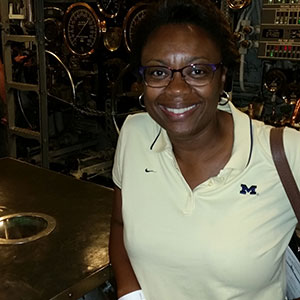
Karen Isble
UMS: What do you love about singing?
Karen Isble: I’ve been a singer all my life. I have two music degrees, one of them in voice performance from the University of Michigan. Earlier in my life, I had visions of becoming a professional performer. When that didn’t come to fruition, I wanted to make sure that I had an opportunity to use that part of myself. Singing became my avocation. I joined the UMS Choral Union in 2007 when I began to work for the University.
UMS: 2007, you’re coming up on eight years with the Choral Union, wow! What are some of the highlights of your experiences with the Choral Union?
KI: One of the highlights, and there have been many, was singing the Saint Matthew Passion several years ago in what was the last blizzard of that spring. I work here on campus, so I had an advantage over a number of folks who were coming in, some people come from as far as Ohio, and certainly from the rest of southeastern Michigan or East Lansing. Members of the Detroit Symphony were coming in from Detroit. We had a children’s choir coming in from Michigan State University.
This snow storm was horrible, and I think it was going to be a three hour concert. As the choir arrived, UMS president Ken Fischer came out on stage and said, “Let’s everybody get the choir on stage. We’re waiting for the orchestra to get here, we’re waiting for the kids to get here, go out and wave your hands so that the audience knows something’s happening.” So, I think, the choir, or those of us who had made it there, ended up going out and sitting on the risers for about an hour while we sort of waited for everyone else to arrive.
Amazingly, the house was packed. I thought there’d be tons of empty seats, but the audience was full to the rafters, all the way up to the second balcony. As each group of musicians showed up, these cheers would go up from the audience. And once the children’s choir arrived, there was an ovation. So then, about an hour late, we dove into this wonderful, wonderful, incredible piece of music, which I hadn’t sung in about twenty years up to that point. So I was really thrilled to have the opportunity to do it again. I had a small solo that Jerry Blackstone had granted me. It was a very transformative performance. It was just this badge of honor, we had made it through this blizzard and we had a wonderful evening.
UMS: A truly “Michigan” story!
KI: There were tales of people abandoning their cars. I remember that a member of the choir said, “I abandoned my car, I couldn’t drive any further. I just walked the rest of the way.” That sort of thing.
UMS: Has there been anything surprising in your experience with the Choral Union? Something that has challenged you or something that’s been a particularly good learning experience for you as a singer?
KI: Before the Choral Union, I’d mostly done solo singing, chamber music, small choir singing, and I wasn’t really sure I would enjoy singing with a group this size. Every year we’d start out with close to 200 folks of every skill level. What has surprised me over and over again is how beautiful and agile a choir of 150 to 200 people can be, and what incredible music we can make. It doesn’t happen all of the time, sometimes we’re just big and loud! But when we have an opportunity to be something a little different, I’m always pleasantly surprised at how well the group comes through.
UMS: It seems that there’s a real sense of community outside of the singing, too, within the group. Would you say that that’s true?
KI: I think that’s true. I think there are a lot of folks, certainly, who have been with the Choral Union for decades, and they have sort of formed that foundation. But I think one of the things that the group does well is have a huge spectrum of participants. We have students who join each year and are part of the equation, and that’s nice, and they’re a little more fluid. Many of the members are also one-time students who have come back a decade later, working in the Ann Arbor area now and looking for another creative outlet.
But definitely a sense of community. I think it grows on you the longer you are there. It takes a bit of time to find your place in a group that big. I certainly feel very at home with the Choral Union though I don’t know everybody, I don’t know that I ever could. You get to know the faces, and when you see them in unexpected places around town you kind of give that high-five or, “Hey, how’re you doing?”
UMS: What would you say to someone who is considering joining the Choral Union?
KI: For me, singing in the Choral Union is my respite from the day-to-day grind. It’s a wonderful escape. It’s hard, actually, sometimes to get myself pumped up for it on a Monday night after a full day’s work, but as soon as we start to sing, it’s almost immediate, and I always leave revitalized. And so I would say if people are thinking about it, weighing adding it to their schedule, that the Choral Union can re-energize you is a really important part of that.
UMS: The Summer Sings on July 6 is the final Choral Union moment for outgoing music director Jerry Blackstone. Would you like to say anything about your experiences with Jerry?
KI: I had the opportunity, as a University of Michigan grad student, to sing with Jerry. As I mentioned, he was the catalyst for my joining the Choral Union. Jerry has fostered the Choral Union community. His ability to be so musical and so warm and so inviting to everyone at every musical level really made the difference during his term as the music director.
Do you sing? New singer auditions for the UMS Choral Union will be held in August and September 2015.
Being a Part of Something Bigger: A Student Perspective on the UMS Choral Union
 Photo: Tsukumo Niwa.
Photo: Tsukumo Niwa.
Tsukumo Niwa will be a junior next year pursuing degrees in Oboe Performance and International Studies at the University of Michigan. In addition to being an active member of the UMS Student Committee and one of this season’s 21st Century Artist Interns, Tsukumo was a UMS Choral Union soprano in the 2013-14 and 2014-15 seasons. Here she writes about her experiences with Ann Arbor’s 137 year-old, Grammy Award-winning community choir: the UMS Choral Union.
I had been singing in choirs throughout Middle and High school, and I didn’t want to quit singing when I got to college. As I looked for singing opportunities, I came across the UMS Choral Union. Although my academic and extracurricular commitments keep me very busy, I found that the time commitment (2.5 hours weekly) was doable. It turned out that joining the UMS Choral Union was one of the best choices I have made at the University of Michigan.
With the UMS Choral Union, I got to experience many opportunities that I would otherwise not have experienced. I’ve met many people from different walks of life, all of whom contribute to the friendly atmosphere in rehearsals in their own way — taking attendance, leading the difficult passages by example, throwing jokes around, or simply smiling and singing away. While some members are students at Michigan like myself, others are older and have been in this ensemble for decades. I have really enjoyed the relaxed yet productive atmosphere in which I get to meet adults from the greater Ann Arbor and Detroit area, while also meeting students across disciplines and levels. Not to mention the opportunity to work with wonderful conductors including Dr. Jerry Blackstone, Michael Tilson Thomas, and Leonard Slatkin. In the past two years, I’ve sung in several Handel’s Messiah performances, performed with three different orchestras, participated in a Michigan Football half-time show with 500 singers and the Michigan Marching Band, and celebrated Dr. Blackstone’s last performance as the Musical Director of the Choral Union. It’s been a unique experience that not many other undergraduate students have shared with me, as I wish they did.
Right before the Messiah performance in 2014, one of the choir members said to the group: “Singing… is a chance to be a part of something that is bigger, to accomplish something that you can’t accomplish by yourself.” The UMS Choral Union embodies just that. Every single time I perform with the Choral Union, I know that I am playing an integral role in the ensemble, and I am able to connect with hundreds of audience members through beautiful music. I feel very fortunate to be able to share the music that I love with so many dedicated musicians.
Do you sing? New singer auditions for the UMS Choral Union will be held in August and September 2015.
Behind the Scenes with UMS Choral Union
Watch these behind the scenes moments with the UMS Choral Union and former conductor Jerry Blackstone as they prepared for a performance of Mendelssohn’s Elijah on February 14, 2015.
Interested in more? Explore the history of the UMS Choral Union, learn about new conductor Scott Hanoian, and get the details about upcoming audition information.
A Video History of Handel’s Messiah
In this interview, archivist Richard LeSueur shares the history of this Ann Arbor holiday tradition:
UMS first presented Handel’s Messiah in December of 1879, and we’re kicking off the holiday season with this year’s performances on December 3 and 4, 2016.
Last updated 4/29/2016.
Thomas Sheets (1952-2014)
We are saddened to report that Thomas Sheets, former choir director at First Baptist and former UMS Choral Union conductor, passed away suddenly on April 24, 2014. In the photo above, he conducts the annual Handel’s Messiah performance in 1993. Thomas also worked at the First United Methodist Church in Ann Arbor and at St. John’s Episcopal Parish in Detroit.
Thomas served as UMS Choral Union music director between 1993 and 2003. UMS President Ken Fischer remembers, “In a very short time, Thomas undertook a number of initiatives that are now significant components of the Choral Union experience. Thomas launched Summer Sings, which celebrated its 20th anniversary last year, and began a relationship with the Detroit Symphony Orchestra that led to the Choral Union becoming the large chorus that performs regularly with the DSO. What a remarkable legacy! Thomas also built relationships with many regional orchestras, providing the Choral Union members with many new and expanded opportunities to perform the great choral repertoire. Our thoughts and prayers are with Thomas’ family and friends.”
Thomas Sheets was 62 years old. The funeral service took place at St. Luke Episcopal Church in Prescott, Arizona. A memorial will take place locally on Saturday, May 17, 2014 at 11 am at First Baptist Church in Ann Arbor.
Handel’s Messiah: A history in photos, programs, and video
This post is a collaboration between UMS interns Meaghan McLaughlin and Kayla Silverstein.
UMS has a history of 135 years of hosting unique performers and bringing talents all over the world to perform on Ann Arbor stages. A massive factor in the founding of UMS and a piece of its history still today is the annual presentation of Handel’s Messiah. While history has changed the presentation of this monumental piece, the tradition is one that UMS patrons can look forward to every year. But when did it all begin?
Handel’s Messiah is a UMS tradition; the work has been performed in its entirety every year since 1941. Records indicate that the first time the UMS Choral Union presented this holiday piece was with a small choir, a mere fraction of the Choral Union today. Upon their first meeting, the choir director at the time, Dr. Henry Simmons Frieze, chose a piece out of Handel’s Messiah. The group quickly decided to devote their time and energy into mastering a few select portions of this work, meeting every Tuesday to rehearse. Their first concert was small but intimate, performed in the M. E. Church on December 16, 1879.
Photos from the UMS Archives.
This small-scale performance of Handel’s Messiah is rare today. The piece is most commonly heard with a large choir backed by an orchestra. The pioneers of the UMS Choral Union performed solely with a double string quartet and two pianos. Not quite what Handel had in mind, but I think he would appreciate the effort of these trend-setting singers.
The concert included ten works in addition to the two chosen choruses of Messiah: “For unto us a Child is Born” and “Lift up Your Head, O Ye Gates.” With so much attention and time devoted to learning Messiah, it fast became a tradition of the ensemble to study and perform bits of the work every December.
Fortunately for audiences today, the performance and tradition of Handel’s Messiah has grown and evolved with the times. The Choral Union today consists of 175 accomplished voices, a much fuller sound that gives Messiah that extra bit of power. Full orchestral accompaniment is now standard with the yearly performances as well as Hill Auditorium as the venue – an acoustically-blessed building that produces the rounded sound that brings the work to life.
Want more Messiah history? Check out the program for the original Messiah performance or watch our video history of Handel’s Messiah.
Share your favorite Messiah memories in the comments below.
Kayla Silverstein is a fourth-year undergraduate student at the University of Michigan, pursuing a dual degree in English and Creative Writing with a minor in French. She works as an intern in both the marketing and programming departments at UMS. In her free time, she enjoys running, drinking obscene amounts of coffee, and writing short fiction.
Meaghan McLaughlin is a former UMS Intern and a 2013 U-M graduate
This Day in UMS: Sergei Rachmaninoff
Editor’s Note: “This day in UMS History” is an occasional series of vignettes drawn from UMS’s historical archive. If you have a personal story or particular memory from attending the performance featured here, we’d love to hear from you in the comments.
November 11, 1920: Sergei Rachmaninoff in UMS Choral Union Series
Photo: Advertisement in the Ann Arbor News (Ann Arbor News Ann Archives, Arbor District Library).
The celebrated Russian pianist and composer Sergei Rachmaninoff performed solo in Hill Auditorium as part of the 42nd season of the Choral Union Series on November 11, 1920. He opened his recital with a performance of “The Star Spangled Banner,” during which the entire audience remained sanding. The remainder of his program consisted of six pieces: Beethoven’s Sonate Opus 90 in e minor, Mendelssohn’s Six Songs Without Words, Chopin’s Ballade, Valse, and Barcarolle, Grieg’s On the Mountains, Liszt’s Rhapsodie Espagnol, and his own Prelude, C-sharp minor Etude-Tableaux, Opus 33.
His masterful tone, unique personality, and flawless technique delighted a sold out Hill Auditorium, as audience members were in awe of his interpretation of his own works and how he portrayed the sorrow and fatalism of his own Russia. Sergei Rachmaninoff returned to Ann Arbor and Hill Auditorium for a second time in 1939, performing another solo recital as part of the 61st Choral Union Series.
Ralph Williams talks about Oresteia of Aeschylus
Ralph Williams, Professor Emeritus of English at the University of Michigan, gave a lecture on the Oresteia of Aeschylus prior to a UMS Choral Union rehearsal. The UMS Choral Union performs as part of Darius Milhaud’s Oresteia of Aeschylus on April 4.
Lecture:
Want to learn more about the project? Read interviews with composer William Bolcom, who studied with Darius Milhaud, Kenneth Kiesler, conductor, Jerry Blackstone, chorus master, and Joseph Gramley, co-director of percussion.
UMS Choral Union music director Jerry Blackstone with Beethoven
The UMS Choral Union took the stage this weekend in Detroit for a performance of Beethoven’s 9th with the Detroit Symphony Orchestra! Here’s UMS Choral Union music director Jerry Blackstone with Ludwig himself backstage.
Handel’s Messiah: 50 Years of Memories
As the Group Sales Coordinator at UMS, I speak with UMS concertgoers each year in late summer who are looking to book their group reservations as soon as possible. Without fail, several of these calls are for our annual presentation of Handel’s Messiah. As Delores Forsmark and I were speaking about her reservation this year, she shared with me that she and her husband have attended the Messiah performance for more than 50 years. I asked Delores if she would consider sharing some favorite experiences with us, and her husband Bert sent me a wonderful letter explaining how significant this holiday tradition has become for them.
Bert first heard the piece in its entirety after receiving the LP as a Christmas gift from his brother. Delores and Bert began attending the Messiah together in 1958, when Delores was a student at the University of Michigan. He and Delores have made the drive from Flushing, sometimes even in harsh winter snow and ice storms, almost each year since then. Bert writes, “Except for a few times when our kids were small, we have attended performances at Hill Auditorium (or the Michigan Theater, during the renovation) almost without exception, always with guests.”
Ever since that first interaction with the piece, the Forsmarks feel a special connection with the Messiah. Bert told me about how a painting he and Delores purchased, Dali’s Crucifixion, made him remember the lyrics “All we like sheep have gone astray: we have turned every one to his own way…”. Bert recalls, “That was in 1965, and as I sit here typing this, I still weep.”
Bert and Delores’ most memorable Messiah performance was in 1983. Having attended with 42 of their fellow church members and their pastor, Bert recalls how the soprano soloist that year brought a new significance to the performance. He still vividly remembers the passion she brought to the piece: “When she sang ‘Rejoice, rejoice, rejoice greatly’, her face glowed, and the audience rejoiced with her. She easily stole the show, and was the talk of the whole busload.” That soloist was Kathryn Bouleyn, also known as Kathryn Day, who previously performed in the Messiah at UMS in 1976, 1977, and 1978.
At UMS, we know that many of you share the Forsmarks’ appreciation for our annual production of the Messiah. Dr. Andrew Berry has also been attending for more than 50 years – he writes, “This is the beginning of my Christmas season every year. We always have a group, and we carpool to have dinner afterwards.” So what are your favorite memories? What is it about this performance that makes it so special for you? What are you most looking forward to when you walk into Hill Auditorium this year? We hope you’ll share your stories, and we look forward to starting up the holiday season with you this weekend.
It used to be that I found the repeated Amens at the conclusion to be tedious, but now I hear them as joyous Amens rolling through the heavens when the redeemed are gathered as the parts are sung, and at the conclusion sigh and say, ‘Only 364 days until the next one.’ -Bert Forsmark
Volunteer Spotlight: UMS Choral Union
After moving to Ann Arbor three and a half years ago, one of my first orders of business was to go online to find a chorus that I could audition for. Being a classically-trained singer coming from Jacksonville, Florida and having sung with the Jacksonville Symphony Chorus throughout the three years I lived there, I knew choral music-making was a part of my life I wanted to continue in Ann Arbor. It seemed a logical first step to go to the Detroit Symphony Orchestra’s website where I would presumably find audition information about their symphony chorus. Instead, I discovered that they did not have their own chorus, but performed choral pieces with a group called the UMS Choral Union. I decided to find out a little more about this chorus and discovered some particularly impressive facts: the group has a 132-year history, they won a Grammy Award in 2006, and they have 180 members. I had certainly found my chorus! An audition, countless Monday night rehearsals, and several incredibly memorable concert experiences later, singing with the UMS Choral Union has been everything and more that I hoped it would be!
Throughout my time singing with the Choral Union, I have always been amazed by the incredible variety of backgrounds, ages, and even geographic locations of the people that make up this volunteer ensemble. I recall from this past winter, one of my fellow choristers arriving to the rehearsal following the gold medal hockey game of the Vancouver Winter Olympics wearing a Team Canada hockey jersey and moose antlers! Yes, we even have singers that come from Windsor, Ontario to be a part of this amazing group. The UMS Choral Union holds auditions for new singers twice a year – once in the spring and once in the fall, and everyone is welcome to audition.
Despite all the diverse interests of the singers in the Choral Union, there is one unifying quality that brings us all together, and makes us more than happy to donate our time: our love of singing and making music as an ensemble. And this is exactly what we do when we come together for our two and a half hour-long rehearsals every Monday night to prepare the, on average, four pieces of music we perform with either the DSO or A2SO throughout the year. These rehearsals are led by conductor Jerry Blackstone, who has been the director of the UMS Choral Union since 2004. In the upcoming 10/11 season, Jerry will be preparing us for performances of Handel’s Messiah (a Choral Union tradition!), Mahler’s Symphony No. 8, Beethoven’s Symphony No. 9, and Mahler’s Symphony No. 3.
I’ve had people ask me “why do you give so much of your time to the Choral Union when you don’t get paid?” Simple: singing under the baton of legendary conductor Sir Neville Marriner, looking out into a packed house from the stage of Hill Auditorium after an unforgettable performance of Mahler’s Symphony No. 2 with the San Francisco Symphony, and getting a lump in my throat as I sing the final measures of the Alleluia in “Worthy is the Lamb” from Handel’s Messiah, even though I’ve sung it dozens of times before. These are all memories I have from the past year of singing with the UMS Choral Union; memories that are quite special to me…why would I not be involved in this incredible ensemble? I can hardly wait for the musical experiences ahead this season!
Additional UMS 10/11 Events
UMS is pleased to announce additional concerts in the 10/11 season that are not part of our genre-specific packages. These events are all part of UMS’s popular Monogram Series, which allows audience members to select at least five events and receive a 10% discount.
Rosanne Cash: The List
Saturday, September 25 | 8 pm
Hill Auditorium
When Roseanne Cash was 18 and on the road with her father, the incomparable country music superstar Johnny Cash, he became alarmed at the number of songs that she didn’t know. As the tour progressed, he developed a list on a legal pad — “100 Essential Country Songs” — and gave it to her with a thinly veiled admonishment that she needed to do her homework. Now, more than 30 years later, Cash has selected a dozen songs from the syllabus presented to her by her father and has recorded her first album of covers, filtered through her own unique, sophisticated perspective. The List presents Roseanne Cash like you’ve never heard her before, as she embraces her heritage and sings for the pure love of these songs that have shaped who she is as an artist.
Mariachi Vargas de Tecalitlán
Saturday, November 6 | 8 pm
Hill Auditorium
With a history that dates back to the late 1890s, the Mariachi Vargas de Tecalitlán was founded in a small city near Jalisco by Don Gaspar Vargas. This band basically invented the modern mariachi, and five generations later, are still playing today. The group spent its formative years defining their sound and experimenting with different instrumental lineups. Today the group is comprised of two harps, one vihuela, one guitar, one guitarron, two trumpets, and six violins. The songs they sing cross over from one generation to the next, making their performances appealing to both young and mature audiences. Recognized as “el major mariachi del mundo” (the greatest mariachi in the world), Mariachi Vargas are the masters at melding the old world style of mariachi music with new innovative pieces.
Stew and The Negro Problem
with Heidi Rodewald
Thursday, November 18 | 8 pm
Friday, November 19 | 8 pm
Saturday, November 20 | 7:30 pm & 10:30 pm
Location TBA
“Stew’s endlessly inventive music draws on rock, gospel, soul, and blues…A winning tribute to the diversity of the black musical experience.” (Hollywood Reporter) Songwriter Stew’s career took an unexpected turn in 2006. After a successful career fronting his critically acclaimed bands, Stew and The Negro Problem, he transformed his life story into the rock musical Passing Strange. The show, co-composed with Heidi Rodewald, earned him the 2008 Tony Award for “Best Book of a Musical” and attracted the attention of Spike Lee, who produced the film, which premiered at the 2009 Sundance Film Festival and airs on PBS’s “Great Performances.” Compared in the same breath with Kurt Weill, Burt Bacharach, and Jackie Gleason, Stew’s concert performances are coveted for their literate precision, sly humor, and deep emotional resonance, hovering between the divergent worlds of rock and theater. “Something hipper for the hipper…Stew is a very genial and lovable guide through the common travails of life. Like a lot of fine writers and musicians, he has the ability to layer reflexive self-doubt into his music and lyrics…very witty, very smart.” (Chicago Tribune)
Carolina Chocolate Drops
Friday, December 3 | 8 pm
Michigan Theater
“Tradition is a guide, not a jailer. We play in an older tradition but we are modern musicians,” says Justin Robinson, a member of the popular bluegrass band, the Carolina Chocolate Drops. The group’s name is a tip of the hat to the Tennessee Chocolate Drops, who lit up the music scene in the 1930s. Inspired by old-time fiddler Joe Thompson, at whose home they jammed every Thursday night during the summer and fall of 2005, the CCD starting playing anywhere people would listen — town squares, farmers’ markets, and ultimately festivals and concert halls, where their foot-tapping music linked the deep tradition of the past with “dirt-floor-dance electricity.” (Rolling Stone) Their sellout shows at the Ark last year reinforced how far they’ve come in a very short time. “This striking North Carolina trio brings a modern sizzle to the legacy of classic African American stringbands…sparking an electrifying ruckus.” (Spin)
Handel’s Messiah
Ann Arbor Symphony Orchestra and UMS Choral Union
Jerry Blackstone conductor
Saturday, December 4 | 8 pm
Sunday, December 5 | 2 pm
Hill Auditorium
The Grammy Award-winning UMS Choral Union (2006 Best Choral Performance for William Bolcom’s Songs of Innocence and of Experience) launches the holiday season with its signature work, Handel’s glorious oratorio Messiah. An Ann Arbor tradition in the beautiful surroundings of Hill Auditorium, these performances are ultimately the heart and soul of UMS, connecting audiences with the talented people on stage, but also with the friends and family who attend each year. Those who have been coming for decades say that the chorus has never sounded better.
Joanne Shenandoah
Sunday, January 23 | 4 pm
Rackham Auditorium
One of today’s most revered Native American singers and songwriters, Joanne Shenandoah is a Wolf Clan member of the Iroqois Confederacy, Oneida Nation whose Native name, Deguiya whah-wa, means “she sings.” The singer/songwriter has performed with such legendary entertainers as Kris Kristofferson and Willie Nelson and has won more Native American Music Awards (Nammies) than any other artist. The daughter of two talented musicians (her father, a jazz guitarist, played with Duke Ellington), Shenandoah was an architectural systems engineer before forging her successful career as a musician. “From my office window I saw a tree being cut down and knew that I, too, had been uprooted and needed to follow my natural gift,” she says. Shenandoah’s original compositions, combined with a striking voice, enable her to embellish the ancient songs of the Iroquois using a blend of traditional and contemporary instrumentation.
Blues at the Crossroads: The Robert Johnson Centennial Concert
featuring Big Head Todd & The Monsters
David “Honeyboy” Edwards
Hubert Sumlin
Cedric Burnside
and Lightnin’ Malcolm
Thursday, February 10 | 8 pm
Hill Auditorium
Straight from the heart of the back country, Blues at the Crossroads has a direct connection back to Robert Johnson (1911-1938), among the most famous of Delta blues musicians. Johnson’s landmark recordings in the 1930s displayed a remarkable combination of singing, miraculous guitar skills, and songwriting talent that have influenced generations of musicians, including Eric Clapton, who called him “the most important blues singer that ever lived.” This concert picks up the thread of Johnson’s legacy in Mississippi at the junction of US Highways 61 and 49, the very crossroads where, as legend has it, Robert Johnson made a deal with the devil, giving up his soul to write the most incredible blues the world had ever heard. The concert features Big Head Todd & The Monsters, as well as David “Honeyboy” Edwards, who at 94 is the only living person to have played with Robert Johnson before his untimely death at age 27 — believed to have been caused by poisoning from a bottle of whiskey that was laced with strychnine.
Kodo Drummers
Wednesday, February 23 | 8 pm
Hill Auditorium
In ancient Japan, the taiko drum was a symbol of the rural community, and it is said that the limits of the village were defined not by geography, but by the furthest distance from which the taiko could be heard. With its “One Earth” tour, Kodo brings the sound of the taiko to people around the globe, transcending barriers of language and custom and reminding all of our membership in that much larger community, the world. “In this age of exploding populations and lightning-fast communication, it is more important than ever that these diverse cultures learn to recognize and accept each other so that all may share our increasingly shrinking planet in harmony,” according to Kodo’s primary philosophy. The Japanese characters of the company’s name convey two meanings: “heartbeat,” the primal source of all rhythm, and “children of the drum,” a reflection of Kodo’s desire to play their drums simply, with the heart of a child.
Tony Allen’s Secret Agent
Saturday, April 16 | 8 pm
Hill Auditorium
The drummer behind the late Nigerian bandleader Fela Anikulapo Kuti, Tony Allen is probably the most highly-regarded African drum set player to emerge since World War II, with drummers and other musicians of all backgrounds marveling at his polyrhythmic style. Kuti is largely considered the most influential African popular musician of the post-colonial era, and Tony Allen was his crucial collaborator in the synthesis of jazz, funk, and highlife that resulted in the style known as Afrobeat.Born in Nigeria in 1940 of mixed Nigerian and Ghanaian parentage, Allen is influenced by everything from European ballroom dance music to big-band jazz drumming, indigenous percussion traditions, and the tradition of modern jazz drumming typified by such musicians as Art Blakey, Elvin Jones, and Max Roach. After playing for years in the shadows of better-known musicians, Tony Allen is now starting to receive the worldwide credit he deserves as one of the most dynamic players of the drum set. “Without Tony, there’d be no Afrobeat.” (Fela Anikulapo Kuti)
Other events on the Monogram Series:
Paul Taylor Dance Company
Sankai Juku: Hibiki
Grupo Corpo
Merce Cunningham Dance Company
The Hot Club of San Francisco and the Hot Club of Detroit/Django Reinhardt 100th Birthday Celebration
Wynton Marsalis and Jazz at Lincoln Center Orchestra
Vijay Iyer Trio and Rudresh Mahanthappa’s Apex
Septeto Nacional Ignacio Piñeiro de Cuba
Susurrus
Laurie Anderson’s Delusion
Druid Theater Company: Martin McDonagh’s The Cripple of Inishmaan
Propeller Theater Company: Shakespeare’s Richard III and The Comedy of Errors
Divine Voices (St. Francis of Assisi Catholic Church)
Jordi Savall and La Capella Reial de Catalunya with Hesperion XXI and Temembe Ensamble
The Tallis Scholars
Sequentia
Jerusalem String Quartet
Nadja Salerno-Sonnenberg and New Century Chamber Orchestra
Concertante and Rafał Blechacz, piano
Takács Quartet: Schubert Concert 2
Takács Quartet: Schubert Concert 3
Tetzlaff Quartet
Venice Baroque Orchestra
The Cleveland Orchestra
Rafał Blechacz, piano
Detroit Symphony Orchestra/Mahler’s Symphony No. 8
Bach Collegium Japan/Bach’s Mass in b minor
Liebeslieder Waltzes
******************************************
GLOBAL FOCUS ON THE AMERICAS
******************************************
This season’s global series explores The Americas — North, South, and Latin — with 19 different events representing something uniquely different about this part of the world. The events featured on The Americas series are:
Roseanne Cash (Sat Sep 25)
Tembembe Ensamble Continuo/The Route of the New World: From Spain to Mexico (Thu Sep 30)
Paul Taylor Dance Company (Thu-Sat Oct 7-9)
Venice Baroque Orchestra/Philip Glass’s “American Four Seasons” (Wed Oct 27)
ONCE.MORE Festival: The Historic Concert (Tue Nov 2)
Mariachi Vargas de Tecalitlán (Sat Nov 6)
Stew and The Negro Problem with Heidi Rodewald (Thu-Sat Nov 18-20)
Carolina Chocolate Drops (Fri Dec 3)
Laurie Anderson’s Delusion (Fri-Sat Jan 14-15)
Renée Fleming soprano (Sun Jan 16)
Grupo Corpo (Fri-Sat Jan 21-22)
Joanne Shenandoah (Sun Jan 23)
Baby Loves Salsa (family performances) (Sun Jan 30)
The Cleveland Orchestra (Tue Feb 1)
Wynton Marsalis and Jazz at Lincoln Center Orchestra (Wed Feb 2)
New Century Chamber Orchestra/Astor Piazzolla’s “Four Seasons of Buenos Aires” (Fri Feb 4)
Blues at the Crossroads: The Robert Johnson Centennial (Thu Feb 10)
Vijay Iyer Trio and Rudresh Mahanthappa’s Apex (Sat Feb 12)
Merce Cunningham Dance Company: The Legacy Project (Fri-Sat Feb 18-19)
Detroit Symphony Orchestra (Sat Mar 19)
Septeto Nacional Ignacio Piñeiro de Cuba (Thu Apr 7)
Tickets to individual events on the series go on sale on Monday, August 23 (via www.ums.org) and Wednesday, August 25 (in person and by phone).


